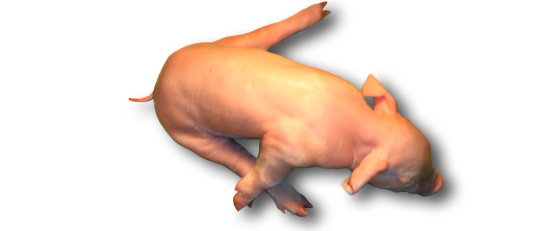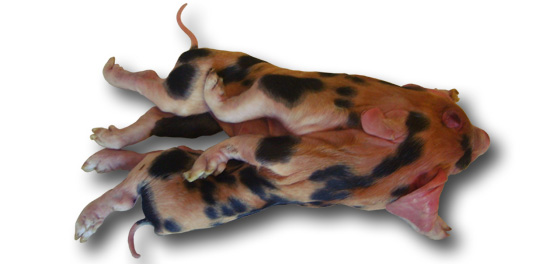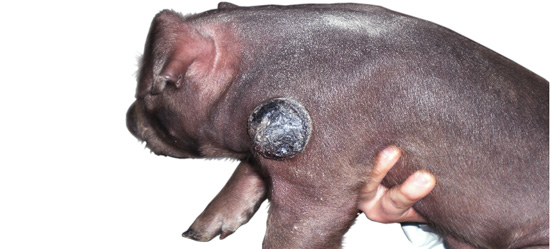So what about the incidence of these ‘genetic’ defects? There are many reports in the literature but most involve limited numbers and/or do not define genotypes or environments. Below is a summary from four different reports with ‘good’ data:
| Steane, 1985 | Partlow, 1993 | Bampton, 1994 | Done, 1972 | Mean | |
| Atresia ani | 0.30 |
0.15 |
0.12 |
0.23 |
0.20 |
| Splayleg | 0.15 |
0.87 |
0.21 |
0.70 |
0.48 |
| Inquinal/scrotal hernia | 0.13 |
0.56 | |||
| Umbilical hernia | 0.30 |
0.39 |
0.28 |
0.11 |
0.27 |
| Cryptorchid | 0.24 |
0.39 |
0.02 |
0.22 |
0.22 |
| Intersex |
0.09 |
0.08 |
0.04 |
0.06 |
0.07 |
| Kinky tail |
1.70 | 0.03 |
0.40 |
0.71 | |
| Ear defects |
0.76 | 0.08 |
0.03 |
0.29 | |
| Cleft palate | 0.01 | ||||
| Major leg deformity | 0.22 |
0.06 | |||
| Pitryisis rosea | 0.21 | ||||
| Tremors | 0.06 | ||||
| Female genital defect | 0.08 | ||||
| Other | 0.42 |
1.21 |
1.76 |
0.05 | |
| Total | 4.96 | 3.09 | 2.87 | 2.77 | 3.42 |
Based on these data, splayleg appears to be the most common ‘economic’ defect.

Note that many defects are rare including siamese twins, cleft palate and jaw defects.

In the Table note the significant variation between the populations in the estimated percentages of specific defects. However, from these reports it can be seen that a herd level of between about 2.5% to 5.0% can be considered ‘normal’. One factor that results in the differences seen between populations is the choice of genotype. For example, Done et al, reported that the incidence in the litters born to Large White x Landrace females depended on the breed of the sire:
| Large White Sire | Landrace Sire | |
| Atresia ani | 0.14 |
0.31 |
| Splayleg | 0.14 |
1.25 |
| Inquinal/scrotal hernia | 0.44 |
0.67 |
| Umbilical hernia | 0.16 |
0.05 |
| Cryptorchid | 0.13 |
0.31 |
| Kinky tail | 0.70 |
0.09 |
| Pitryisis rosea | 0.08 |
0.33 |
| Other | 0.20 |
0.43 |
| Total | 1.99 | 3.44 |
Another example of a breed difference is the incidence of melanoma which is significantly higher in the Duroc breed and certain minature breeds developed for medical research.

As the above cited data reflected the genetics and management of some twenty years ago a recent confidential survey was undertaken in a large anonymous European Breeding Company dam-line (Large White and Landrace) nucleus/multiplier over a four year period ending March 2010. In total, 175,843 purebred and first-cross pigs born were evaluated by trained technicians who recorded every born pig within twelve hours of birth in the farrowing house to establish the incidence of congenital defects (seen at birth):
| Defects as % of Total Pigs Born | |
| Inquinal/scrotal hernia | 0.383 |
| Umbilical hernia | 0.001 |
| Female genitalia | 0.020 |
| Cryptorchid | 0.410 |
| Intersex | 0.080 |
| Other | 0.010 |
| Total | 0.904 |
Additional assessments were made at 45kg ± 5kg and 95kg ± 9kg to estimate the incidence of defects occurring after parturition and up to an average of 95kg live weight:
| Defects post birth to 95 kg | |
| Inquinal/scrotal hernia | 0.65 |
| Umbilical hernia | 0.48 |
| Female genitalia | 0.02 |
| Forelimb defect | 0.15 |
| Other | 0.09 |
| Total | 1.39 |
Note that more than half the total defects were identified in the growing and fattening period rather than at birth. Thus, congenital defects make up only a limited number of total defects observed in herds.
It is not uncommon for herds to have ‘storms’ where the incidence is higher than the levels noted above, particularly for short periods. This is particularly true for the hernias and cryptorchidism where an incidence of 5.0% is not uncommon. These defects together with the economic consequences and control of defects will be considered in later reports.




